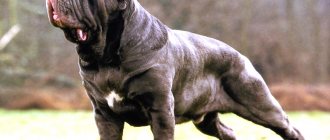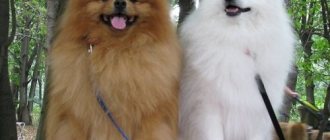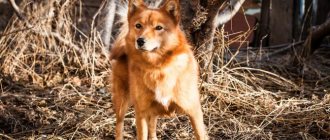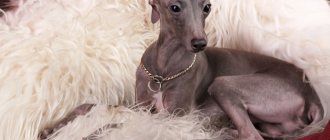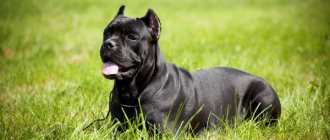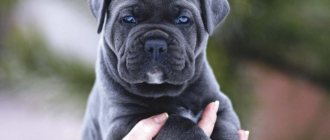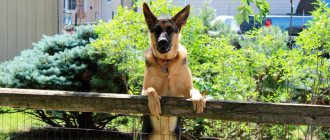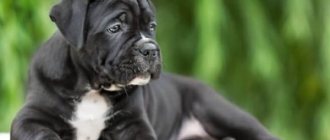Main characteristics
| Breed parameters | |
| Country of origin: | Italy |
| Weight of the breed: | males 45-50 kg, females 40-45 kg |
| Height at withers: | males 64-68 cm, females 60-64 cm |
| Temperament: | active |
| Wool: | short |
| Role in human life: | bodyguard |
Massive, impressive Cane Corsos may seem intimidating at first glance, but if you look closely, you will notice how devotedly they look at their owners and behave tactfully and politely. Due to their good-natured, responsible nature, they can rightly be called family dogs and true friends. The breed is distinguished by its extraordinary intelligence, protective qualities, and high endurance.
Other Cane Corso mixes
Cynologists also know the following “mixes” of Cane Corso with representatives of other breeds.
Photo of a cross between a Cane Corso and a Boxer - Cane Boxer:
Photo of a cross between a Cane Corso and a Rottweiler - Rotti Corso:
Story
Italian Mastiffs are direct descendants of the Tibetan or Molossian Dogo, records of which date back to 1000 BC. In Ancient Rome, these large dogs were used as guards of palaces and temple areas, participated in battles, bear hunts, and performed in the gladiatorial arena. Many graphic images, sculptures, and chronicle descriptions dedicated to the breed have been preserved.
Cane Corso in Ancient Rome
After the fall of the Roman Empire, the breed spread throughout Europe and changed somewhat. They are known to have been crossed with Celtic greyhounds. Chronicle sources from the 14th-15th centuries were discovered describing the participation of massive dogs in baiting game; in some regions they were used in pastures and driving livestock.
During the difficult times of World War II, many breeds of domestic animals were on the verge of complete extinction. This fate did not spare the Cane Corso. In 1973, Professor Giovanni Bonatti and like-minded people attempted to restore the gene pool of the breed. The Quesnel Club of Italy has developed a document approving the standard. By 1992, 500 individuals were registered that could be considered purebred.
The International Canine Organization recognized the breed in 1996. The place of origin of modern representatives is Northern Italy, they are close relatives of the Mastino Neapolitan and descendants of the ancient Allano
.
Character
Cane Corso are good bodyguards; they will protect their possessions from strange animals, strangers, and all kinds of dangers. They feel the mood of the owner, so they gladly receive guests, but they will show aggression when necessary. Children and animals are treated with all my heart, especially if you have known them since puppyhood, or with proper socialization. However, you should not assign them the role of nannies, leaving them alone with the children. It is difficult to anger them, but if it comes to a fight, they will not back down.
However, Italian mastiffs clearly distinguish between play and fighting and try to please their owner in everything. They can become excellent watchmen, protectors, and companions for active walks and hunting. Infinitely devoted to family. They are always on guard so that no living creature thinks of harming their loved ones. It is important that the puppy meets other people, children, and animals. If socialization does not occur at an early age, there may be a manifestation of hostility, or increased anxiety, fear of extraneous sounds.
Character of the Neapolitan Mastiff dog
The character of the Neapolitan Mastiff dog is non-aggressive (however, there are exceptions). This breed is even-tempered, obedient, alert and noble. In a homely atmosphere she is friendly and sociable. Has an excellent memory.
Treats all family members well, including children, but chooses one owner and completely obeys him. She very rarely barks, but is capable of acting with lightning speed. Sometimes it is aggressive towards other dogs, so the owner should be careful during walks. This dog requires training and serious physical activity.
Widely used as a guard dog due to its exceptional natural abilities and strong psyche. Mastino Napoletano is always ready to repel any aggressor; during a fight he fights hard and dangerously. This is an excellent companion dog for a physically active person.
Standard
The breed is considered quite rare, so puppies should be chosen from a reputable breeder. Everything you need to know about the new parameters and external characteristics of this breed is in the 2016 document: FCI - Standard No. 343. The standard appearance of the Cane Corso is shown in the photo.
External data
Powerful, strong. The muscles are dry, without fat folds. Despite its massiveness, the Cane Corso seems to be an aristocratic, neat dog. Boys: grow to 64-68 cm, weight 45-50 kg; girls: height 60-64 cm, weight 40-45. The silhouette is rectangular, the length of the body is slightly longer than the height.
Head
A strong, wide skull, a convex forehead with a noticeable groove in the middle. Developed brow ridges. The length of the muzzle is comparable to its width. The nose is black, large nostrils. The upper lips droop, hiding the lower jaw. The eyes are smart, attentive, the color is preferably dark. The ears are triangular and cannot be cropped.
Teeth
The breed is characterized by massive curved jaws. Teeth with a slight overshot of up to 5 mm.
Neck
Powerful, proportionally equal to the length of the head.
Frame
Strong developed chest, straight strong back, short loin, elongated croup, slightly sloping.
Tail
Thick at the base, does not curl, and is not vertical. They are docked after the 4th vertebra.
Paws
The front legs are strong with flexible wrists. The hindquarters have muscular thighs and moderately developed hocks. Moves with long strides and a sweeping trot.
Wool
Short, hard, shiny, with virtually no undercoat.
Color
Black, blue, lead, light grey, red fawn, dark fawn, brown. The color may be brindle. In fawn and brindle dogs, a mask of black or dark color is acceptable up to the eye line. A white spot on the chest only with even colors, except fawn.
Conditions of detention
Cane Corso feel comfortable in the house and apartment. There is an opinion that it is permissible to arrange enclosures or warm houses, but this is not so. Their homeland is Italy, where there is no need to adapt to frost. In a warm enclosure, dogs miss their owners so much that they are able to knock out the bars. An aviary can sometimes replace a walk, but the Corso needs a lot of space for activity and complete control over the entrusted territory.
A well-mannered dog feels great indoors, does not spoil the owners’ things, and does not cry when waiting for them to come home from work. It is necessary to maintain constant physical tone, while walking you need games, training, obstacle courses, then there is no desire to play pranks at home. However, the Cane Corso is not suitable for running or cycling together.
Keeping a mastiff at home
The Italian Cane Corso has a thick and slightly spiky coat, which perfectly protects the body from hypothermia. Such dogs are not very suitable for living in an apartment (particularly due to their weight), but they often live in the courtyards of private houses. If you choose the second option, then do not forget to insulate the enclosure. Reviews from many owners say that such dogs become very attached to their owners and always miss them when separated.
Sorry, there are no surveys available at this time.
Caring for your pet includes wiping the fur with a damp cloth from time to time. You only need to bathe if an unpleasant odor occurs. You can choose a care product in a special store.
What to feed your dog?
A mastiff's diet must contain a balance of nutrients to maintain an optimal weight. This can be feeding exclusively dry food or natural food (often buckwheat with meat). With proper care and nutrition, your dog's life expectancy will be up to ten years, and his character will be balanced and calm. Various tables provide information about how many vitamins and minerals a dog needs at a certain age, as well as information about weight changes.
Care
Shedding is not intense, but hair falls out constantly, so you will need a special rubber mitten. Water treatments are indicated when the corso becomes dirty or smells unpleasant. It is advisable to avoid the bath in winter, especially in the presence of drafts; you can use dry shampoo from a veterinary pharmacy.
The eyes and ears should be examined for infections. The claws usually wear down on their own during active walks, but if they grow, the plates can become deformed, grow in, and cause pain. You need to get used to using a nail clipper gradually.
Opinions about brushing your teeth vary. As a rule, if you choose specialized treats and toys, there will be no plaque left. Sometimes you can treat yourself to a piece of fresh tomato to remove protein residues from your teeth. If cleaning is still necessary, first let the paste taste. Only a veterinarian can remove tartar.
Diet
The build, size, and fast metabolism of the Italian Cane Corso imply a large amount of food, mainly protein. Throughout life, the need for certain products changes, as does the number of meals. Veterinarians recommend purchasing premium balanced food, but if the owners decide to opt for natural food, they need to study in detail what is recommended to feed the puppy and adult Corso. Portion size is of utmost importance; the breed is prone to volvulus.
Kids
Half of the puppy's diet is boiled poultry or raw beef. Additional dishes: rice and buckwheat porridge in meat broth, with the addition of oatmeal. Up to 4 months you can give cottage cheese, up to 100 grams per day, milk or kefir. The skeleton takes a long time to form and calcium is necessary, but high levels can lead to early hardening of bones and joint diseases. Additionally: grated raw and boiled carrots, gelatin is needed to replenish the lack of collagen. They feed 5 times a day.
Adolescents under one year old
Feeding four-month-old puppies contains beef bones; from six months onwards, the number of meals is reduced to three, and they are treated to offal. Calorie content is increased gradually at the expense of proteins. It is not advisable to cook porridge in strong broth or indulge in fatty meat.
Youth
From one year on, muscle mass begins to grow rapidly, and ligaments and bones need to be strengthened. The diet should be supplemented with beef tripe, tripe, and offal. This food is very healthy and will reduce your meat costs. You can treat them to seasonal fruits, nuts, berries, and switch to a two-meal diet.
Maturity
An adult Cane Corso is fed raw or boiled lean meat, offal, cereals, and boiled vegetables. Girls are given milk before giving birth and during breastfeeding. Boys who are often knitted additionally need animal proteins. Italian Mastiff in his prime photo.
Characteristics and description of the breed
A distinctive feature of the breed are multiple skin folds on the body; Italy is considered its homeland. Since ancient times, the Neapolitan Mastiff has earned respect from its owners for its masculinity, courage and strength. However, many even then noticed how friendly, affectionate and playful a dog of this breed can be. The Neapolitan Mastiff is distinguished by its loyalty, since in order to win over its owner, it is ready to pursue prey for a long time.
Aggressiveness
People unfamiliar with this breed mistakenly believe that the Neapolitan Mastiff is aggressive, but in reality it does not show hostility. A misperception arises from the dog's menacing appearance, but in reality the mastiff is a fairly calm dog that is never the first to show aggression. He can outwardly show that he is extremely unfriendly only if his owners are in danger.
Activity
The Mastino is not particularly active, which makes it a suitable dog breed for apartment living. He feels comfortable in a limited space, but it should not be too cramped, since the Neapolitan Mastiff is a large dog. It is better to get this breed if you have a large apartment - this will provide comfort for both you and your pet.
Training
Because the Neapolitan Mastiff is loyal and loving to his owners, he will always do what they tell him. This breed can disobey only if the dog does not understand the command.
Shedding
During shedding, the dog must be brushed daily. As a rule, this period lasts no more than 10-14 days.
Need for care
Overall, caring for a Neapolitan Mastiff is no different than caring for any other breed of dog of similar size. However, Mastino has its own characteristics, for example, due to the almost complete absence of hair, the skin of such dogs is delicate and more susceptible to irritation. That is why veterinarians recommend bathing the Mastino before shows and as rarely as possible, or selecting special products. The Neapolitan Mastiff is a “drooling” dog, so it is important to teach him to wipe off his drool on his own, otherwise it can cause infections.
Read White dogs - 20 breeds with names
Friendliness and attitude towards children
The Neapolitan Mastiff is particularly friendly; such a dog is an irreplaceable friend and helper who is ready to come to the rescue of its owners even in the most difficult situation. Representatives of this breed also behave calmly with children, but it is necessary for adults to supervise the child when he is with the dog, since the Mastino can perceive loud screams and emotional outbursts as aggression towards itself.
Health
The Neapolitan Mastiff has excellent health and almost never gets sick. Diseases can appear if owners forget about dog hygiene. Saliva is an excellent breeding ground for bacteria, and excessive care (for example, frequent water procedures) washes away the special fatty layer on the skin, which can also cause diseases.
Attitude towards loneliness
Dogs of this breed are very attached to their owners, so they tolerate loneliness quite poorly. The Mastino needs its owner to be constantly nearby, playing with it and paying attention. In addition, representatives of this breed are owners; Neapolitan Mastiffs want their owner to belong only to them and no one else.
Maintenance cost
Keeping a Neapolitan Mastiff is an expensive business, since the owners will not only have to create comfortable conditions for the dog in the form of a cozy and warm sleeping place, but also constantly monitor its appearance, purchase special vitamins, food and toys. Mastino requires grooming, that is, a whole range of measures to care for the animal, constantly disinfect and treat the oral cavity, clean ears and teeth. On average, the owner of a Neapolitan mastiff can spend from 10 thousand to 15 thousand rubles per month.
Intelligence
The Neapolitan Mastiff has a high intelligence; he perfectly understands almost everything that his owner tells him. Mastino remembers commands within a short time and carries them out clearly.
Noise
Mastino is a very calm breed of dog, so it does not make unnecessary noise and behaves with restraint both in front of its owner and in front of strangers. Therefore, this is another reason to get a Neapolitan Mastiff if you live in an apartment.
Security qualities
The Neapolitan Mastiff is a born watchdog. He is capable of scaring off anyone hostile to his owners with his appearance alone. When the Mastiff's owners are threatened, he will use all his abilities to protect them, so you can be sure that the enemy will regret encroaching on your safety or property.
Lifespan
On average, Neapolitan Mastiffs live from 8 to 10 years, but if you follow all the instructions for their care, they can live several years longer.
Education
Raising a Cane Corso pet must be based on mutual respect, encouragement, and approval. Punishments are rarely used if the Corso actively disobeys, tries to dominate, or shows aggression for no reason.
By adulthood, after about 2.5 years, mastering skills becomes more difficult; professional help is needed to correct behavioral problems. The Cane Corso can be trained without dog handlers in conditions where the owner is ready to train at home.
Two-month-old babies whine with fear. The owner should reassure the puppy that it is safe here. It’s time to get used to responding to a nickname, to the commands “place”, “fu”, “come”. The dog is immediately given a corner where neither guests nor children can intrude.
By 4 months, the Italian has all his vaccinations and can go for walks. At this stage of education, grown-up puppies master the orders “sit”, “lie down”, “nearby”. Socialization is necessary, the baby must see dogs, cats, children, and ride in public transport. Reasonable suspicion is encouraged, manifestations of aggression are suppressed.
The remaining skills are gradually mastered. From time to time, the Cane Corso will offer its owner its solutions, this is inevitable until the moment when the developing personality takes a place in the family hierarchy. It is important that the animal feels safe, trusts its owners, but does not dominate any family member. They provide protection to the rest of the pets.
Course recommendations:
- OKD or Dog in the city;
- Bodyguard;
- Obedience course.
When undergoing group training, the dog may be distracted; several sessions will be required to concentrate. For following commands, they are usually treated with a treat, such as a piece of cheese. But later the Corso will demand a reward every time he smells it.
Training and education
Training course required! You should start raising a puppy immediately after purchasing it. Italians are easy to train, but keep in mind that using physical punishment on them is not recommended. The Cane Corso must undergo a general training course and, if necessary, behavioral adjustments. Dogs of this breed are excellent at passing OKD and ZKS due to their endurance and intelligence. Do not forget that the Cane Corso is a serious breed of dog and you take full responsibility for its adequacy and good manners. Cane Corso requires physical and mental exercise, long walking twice a day. If you don’t do this, the dog may chew through all the furniture in the house out of boredom.
Submitting a dog doesn't always work. The principle of complete submission of the Cane Corso to the owner is an outdated method. This theory was formulated based on observations of packs of wild wolves, but they were kept in captivity and, of course, experienced stress. The stress condition forced wolves to show aggression towards each other, but in the wild they do not show aggression to each other - they live together and interact with each other. You need to perceive yourself as the more experienced and mature member of the pack, who is responsible for guiding the new member (Cane Corso puppy) and teaching him good behavior, as well as correcting him if necessary. It is important to remember that Cane Corso puppies learn a lot on their own. They are very inquisitive, love to explore new territories and, of course, experiment. Puppies tend to repeat actions they enjoy (like playing with a toy). They do not repeat actions that cause them pain (for example, destroying a nest and getting bitten). If your Cane Corso puppy misbehaves, ignore him and praise him when he does the right thing. Reward your puppy for following commands and good behavior. Do not neglect these tips. After all, constantly hearing “you can’t” all day long is unbearable. This is a small child who wants to know everything and get his portion of treats as a reward for not eating your favorite rug, going to the toilet outside, bringing you a ball, and so on.
Set rules and monitor their implementation
It is worth enrolling your Cane Corso puppy in obedience training classes. These classes will allow you to understand exactly what actions will allow you to control your dog’s behavior. You will be able to spend more time with your puppy, establish contact and socialize around other dogs.
Adviсe
- Training a Cane Corso puppy should be done with the help of positive motivation; watch carefully special films about this technique. The Canine Translator film series from National Geographic is suitable.
- If you need to leave your puppy at home alone for 2 hours or more, then ask someone to come to him.
- Be sure to make an appointment with your Cane Corso puppy to see the vet as soon as possible. The doctor will carefully examine him and give him vaccinations that will protect him from dangerous diseases.
